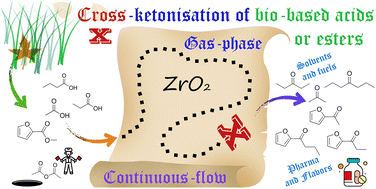An innovative catalytic pathway for the synthesis of acyl furans: the cross-ketonization of methyl 2-furoate with carboxylic acids†
Abstract
The usefulness of ketonization reactions for the valorization of a wide plethora of biomass-derived carboxylic acids is widely recognized; however, the full potential of this reaction has yet to be suitably exploited for the production of high added-value aromatic and/or aliphatic asymmetric ketones. For this reason, herein we report for the first time in the literature the continuous-flow, gas-phase synthesis of 2-acetyl furan (AF) by means of the catalytic cross-ketonization of bio-based 2-methyl furoate (2-MF) and acetic acid (AA) over a simple and cheap ZrO2 catalyst. Interestingly, AF is considered a valuable food additive and a pharmaceutical intermediate for the synthesis of antibiotics. The optimization of the molar ratio between reactants at 350 °C allowed us to achieve 87% AF selectivity at 90% 2-MF conversion, with a space–time yield of 0.152 h−1, a value that is similar to the ones obtained by following the traditional Friedel–Crafts acylation and Wacker oxidation routes. On the other hand, the E-factor of the herein-proposed process is several times lower compared to the aforementioned traditional routes performed in the liquid phase and under batch conditions. Finally, the versatility of the cross-ketonization synthetic approach was successfully demonstrated and applied for the selective synthesis of other valuable acyl furans (i.e., propionyl furan and butyryl furan).



 Please wait while we load your content...
Please wait while we load your content...